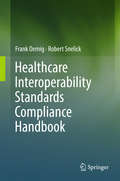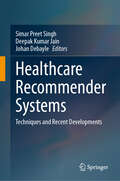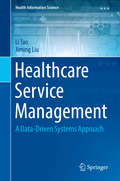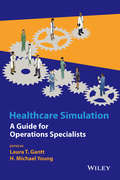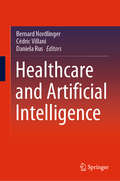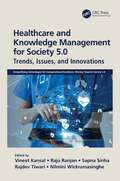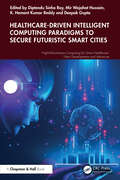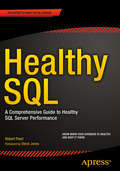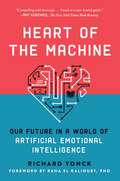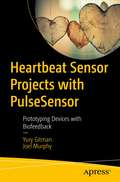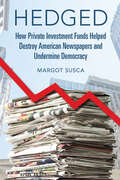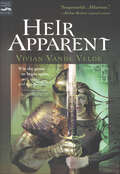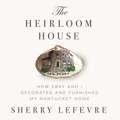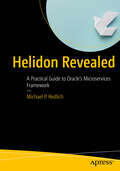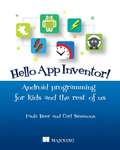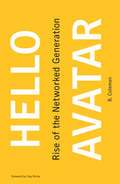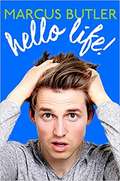- Table View
- List View
Healthcare Interoperability Standards Compliance Handbook
by Frank Oemig Robert SnelickThis book focuses on the development and use of interoperability standards related to healthcare information technology (HIT) and provides in-depth discussion of the associated essential aspects. The book explains the principles of conformance, examining how to improve the content of healthcare data exchange standards (including HL7 v2. x, V3/CDA, FHIR, CTS2, DICOM, EDIFACT, and ebXML), the rigor of conformance testing, and the interoperability capabilities of healthcare applications for the benefit of healthcare professionals who use HIT, developers of HIT applications, and healthcare consumers who aspire to be recipients of safe and effective health services facilitated through meaningful use of well-designed HIT. Readers will understand the common terms interoperability, conformance, compliance and compatibility, and be prepared to design and implement their own complex interoperable healthcare information system. Chapters address the practical aspects of the subject matter to enable application of previously theoretical concepts. The book provides real-world, concrete examples to explain how to apply the information, and includes many diagrams to illustrate relationships of entities and concepts described in the text. Designed for professionals and practitioners, this book is appropriate for implementers and developers of HIT, technical staff of information technology vendors participating in the development of standards and profiling initiatives, informatics professionals who design conformance testing tools, staff of information technology departments in healthcare institutions, and experts involved in standards development. Healthcare providers and leadership of provider organizations seeking a better understanding of conformance, interoperability, and IT certification processes will benefit from this book, as will students studying healthcare information technology.
Healthcare Quality and HIT - International Standards, China Practices (HIMSS Book Series)
by Jilan Liu Jiaxin Wang Xinyue Du Zhuo Li Mu Tian Xiangjuan KongHow Chinese hospitals have been growing and adopting international standards such as JCI and HIMSS EMRAM to fuel their advancements is not well-known to the western world. In this book, Jilan Liu, as former Principal Consultant of JCI and current Chief Executive Officer for HIMSS Greater China, presents a selection of case examples written by Chinese hospital executives and staff showcasing first-hand experiences and insights into how the leading healthcare organizations grow and continue their success in China. The case examples include Chinese hospitals who have participated in JCI accreditation and/or HIMSS EMRAM. These hospitals represent the new wave of organizations adopting international standards while accommodating the unique conditions of China.
Healthcare Recommender Systems: Techniques and Recent Developments
by Simar Preet Singh Johan Debayle Deepak Kumar JainThe book explores the complete system perspective, underlying theories, modelling, and the applications of pattern recognition in Healthcare Recommender System. Considering the interest of researchers and academicians, editors here aim to present this book in a multidimensional perspective that will be covering Healthcare Recommender Systems in depth, considering pattern recognition techniques using amalgamation of emerging technologies. It aims to cover all topics ranging from discussion of recommender system to efficient management to recent research challenges and issues. Editors aim to present the book in a self-sufficient manner and in order to achieve this, the book has been organized into various chapters. The prime focus of the book is to explore the various issues, challenges, and research directions of pattern recognition in Healthcare Recommender Systems. The table of contents is designed in a manner so as to provide the reader with a broad list of its applications. Additionally, the book addresses the transformations in the area of Healthcare Recommender Systems. Thus, the book plans to discuss the recent research trends and advanced topics in the field of healthcare automation system which will be of interest to industry experts, academicians and researchers working in this area. Hence, the editors aim is to cover diversity in the domain while achieving completeness.
Healthcare Service Management: A Data-Driven Systems Approach (Health Information Science)
by Jiming Liu Li TaoHealthcare service systems are of profound importance in promoting the public health and wellness of people. This book introduces a data-driven complex systems modeling approach (D2CSM) to systematically understand and improve the essence of healthcare service systems. In particular, this data-driven approach provides new perspectives on health service performance by unveiling the causes for service disparity, such as spatio-temporal variations in wait times across different hospitals.The approach integrates four methods -- Structural Equation Modeling (SEM)-based analysis; integrated projection; service management strategy design and evaluation; and behavior-based autonomy-oriented modeling -- to address respective challenges encountered in performing data analytics and modeling studies on healthcare services. The thrust and uniqueness of this approach lies in the following aspects: Ability to explore underlying complex relationships between observed or latent impact factors and service performance.Ability to predict the changes and demonstrate the corresponding dynamics of service utilization and service performance.Ability to strategically manage service resources with the adaptation of unpredictable patient arrivals.Ability to figure out the working mechanisms that account for certain spatio-temporal patterns of service utilization and performance. To show the practical effectiveness of the proposed systematic approach, this book provides a series of pilot studies within the context of cardiac care in Ontario, Canada. The exemplified studies have unveiled some novel findings, e.g., (1) service accessibility and education may relieve the pressure of population size on service utilization; (2) functionally coupled units may have a certain cross-unit wait-time relationship potentially because of a delay cascade phenomena; (3) strategically allocating time blocks in operating rooms (ORs) based on a feedback mechanism may benefit OR utilization; (4) patients’ and hospitals’ autonomous behavior, and their interactions via wait times may bear the responsible for the emergence of spatio-temporal patterns observed in the real-world cardiac care system. Furthermore, this book presents an intelligent healthcare decision support (iHDS) system, an integrated architecture for implementing the data-driven complex systems modeling approach to developing, analyzing, investigating, supporting and advising healthcare related decisions. In summary, this book provides a data-driven systematic approach for addressing practical decision-support problems confronted in healthcare service management. This approach will provide policy makers, researchers, and practitioners with a practically useful way for examining service utilization and service performance in various ``what-if" scenarios, inspiring the design of effectiveness resource-allocation strategies, and deepening the understanding of the nature of complex healthcare service systems.
Healthcare Simulation
by H. Michael Young Laura T. GanttA focused guide for healthcare simulation operations in education and training With the growing use of simulation within the field of healthcare, Healthcare Simulation: A Guide for Operations Specialists provides a much needed resource for developing the roles and responsibilities of simulation operations specialists. The book illustrates the current state and evolution of the simulation professional workforce and discusses the topics necessary for the development of this pivotal role. The book promotes the value of simulation in healthcare and its associated outcomes while clarifying the operational requirements of successful simulations. Featuring numerous contributions from international experts, consultants, and specialists, Healthcare Simulation: A Guide for Operations Specialists presents advances in healthcare simulation techniques and also features: Coverage of the best practices and available technologies for healthcare simulation operations specialists within healthcare education, training, and assessment Interdisciplinary, practical examples throughout to help readers better understand the presented material An overview of the many facets of day-to-day operations within a healthcare simulation lab Discussions regarding the concurrent need for understanding proper patient care that accompanies the human-to-machine interface in patient simulation Healthcare Simulation: A Guide for Operations Specialists is an excellent reference for healthcare simulation professionals including administrators, medical directors, managers, simulation technologists, faculty members, and educators in academic and healthcare settings. The book is also a useful supplementary textbook for graduate-level courses related to simulation and certificate programs in simulation education and simulation operations.
Healthcare and Artificial Intelligence
by Cédric Villani Bernard Nordlinger Daniela RusThis book provides an overview of the role of AI in medicine and, more generally, of issues at the intersection of mathematics, informatics, and medicine. It is intended for AI experts, offering them a valuable retrospective and a global vision for the future, as well as for non-experts who are curious about this timely and important subject. Its goal is to provide clear, objective, and reasonable information on the issues covered, avoiding any fantasies that the topic “AI” might evoke. In addition, the book seeks to provide a broad kaleidoscopic perspective, rather than deep technical details.
Healthcare and Knowledge Management for Society 5.0: Trends, Issues, and Innovations (ISSN)
by Vineet KansalHealthcare and knowledge management is the need of the era; this book investigates various challenges faced by practitioners in this area. It also covers the work to be done in the healthcare sector and the use of different computing techniques for better insight and decision-making. Healthcare and Knowledge Management for Society 5.0: Trends, Issues, and Innovations showcases the benefits of computing techniques used for knowledge management in the field of healthcare in the futuristic perspective of having a human-centric society 5.0. The book includes topics related to the use of technologies like artificial intelligence, machine learning, deep learning, Internet of Things, blockchain, and sensors for effective healthcare and management. Case studies are included for easy comprehension and the book covers the most up-to-date research in the field. The use of techniques like artificial intelligence in the field of knowledge management is also discussed.This book is intended for researchers and academicians to explore new ideas, techniques, and tools. Researchers working in interdisciplinary research can also find many interesting topics which will pave the way for a new arena in healthcare and knowledge management.
Healthcare-Driven Intelligent Computing Paradigms to Secure Futuristic Smart Cities (High-Performance Computing for Smart Healthcare)
by Deepak Gupta Diptendu Sinha Roy Mir Wajahat Hussain K. Hemant Kumar ReddyHealthcare-Driven Intelligent Computing Paradigms to Secure Futuristic Smart Cities presents the applications of the healthcare sector in the context of futuristic smart cities. It explores various applications like the advancements in computational and network models along with the innovative paradigms for an able healthcare model. The book discusses the state-of-the-art intelligent network and computing paradigms and machine learning models for robust healthcare. This book is for academicians, researchers, and entrepreneurs working on healthcare-driven intelligent computing paradigms to secure futuristic smart cities. It includes several aspects of the challenges faced by a futuristic smart city in healthcare, includes challenges emanating from the immense data generated by the wearable sensors, data analysis, and security concerns owing to the patient-related data. It works as a pertinent resource on how cutting-edge technologies can be integrated to aptly provide solutions for the numerous challenges faced by the healthcare industry. Includes several use cases, practical challenges, and solutions for executing smart healthcare.Features Covers a multitude of computing paradigms viz; Cloud computing, Fog Computing, and Mist Computing Healthcare is discussed leveraging smart city, so it can potentially identify the gaps and present some newer use cases to handle future pandemics The network aspect is also covered with an inclusion of the next-generation paradigm which is Software Defined Networking (SDN) Security and privacy issues are considered, which is crucial to handle security-related aspects Machine Learning models are also discussed to provide any entrepreneur develop a business model involving cutting-edge technologies This book is for academicians, researchers, and entrepreneurs working on healthcare-driven intelligent computing paradigms to secure futuristic smart cities.
Healthy SQL
by Robert Pearl"Robert Pearl, a well-known DBA in the SQL community, explains his holistic vision of a database instance that needs regular check-ups and gives the tools, scripts, and best practices he has collected over the years. " Alberto Bolchini, Computing Reviews, May 9, 2016 Healthy SQL is about ensuring the ongoing performance health of a SQL Server database. An unhealthy database is not just an inconvenience; it can bring a business to its knees. And if you are the database administrator, the health of your SQL Server implementation can be a direct reflection on you. It's in everyone's best interest to have a healthy SQL implementation. Healthy SQL is built around the concept of a medical checkup, giving you the tools you need to assess the current health of your database and take action to improve upon that health and maintain good performance to your business. Healthy SQL aids in developing a rigorous routine so that you know how healthy your SQL Server machines are, and how you can keep those same servers healthy and fit for duty. The book is filled with practical advice and a time-tested strategy, helping you put together a regimen that will ensure your servers are healthy, your implementation is fully optimized, your services are redundant and highly available, and you have a plan for business continuity in the event of a disaster. If your current environment doesn't match up with these criteria, then pick up a copy of Healthy SQL today and start your journey on the road to a fit and tight SQL Server deployment.
Heart of the Machine: Our Future in a World of Artificial Emotional Intelligence
by Richard YonckFor Readers of Ray Kurzweil and Michio Kaku, a New Look at the Cutting Edge of Artificial Intelligence Imagine a robotic stuffed animal that can read and respond to a child’s emotional state, a commercial that can recognize and change based on a customer’s facial expression, or a company that can actually create feelings as though a person were experiencing them naturally. Heart of the Machine explores the next giant step in the relationship between humans and technology: the ability of computers to recognize, respond to, and even replicate emotions. Computers have long been integral to our lives, and their advances continue at an exponential rate. Many believe that artificial intelligence equal or superior to human intelligence will happen in the not-too-distance future; some even think machine consciousness will follow. Futurist Richard Yonck argues that emotion, the first, most basic, and most natural form of communication, is at the heart of how we will soon work with and use computers. Instilling emotions into computers is the next leap in our centuries-old obsession with creating machines that replicate humans. But for every benefit this progress may bring to our lives, there is a possible pitfall. Emotion recognition could lead to advanced surveillance, and the same technology that can manipulate our feelings could become a method of mass control. And, as shown in movies like Her and Ex Machina, our society already holds a deep-seated anxiety about what might happen if machines could actually feel and break free from our control. Heart of the Machine is an exploration of the new and inevitable ways in which mankind and technology will interact.
Heartbeat Sensor Projects with PulseSensor: Prototyping Devices with Biofeedback
by Yury Gitman Joel MurphyBring live heartbeats and heart rate data into your electronics projects as an impressive feature that builds user engagement. If you’re a Maker, developer, or artist, you’ve probably run into common, frustrating stumbling blocks for incorporating bio-sensors. Get the upper hand on smoothly integrating heartbeats into your projects on any platform with PulseSensor. First, you'll explore working with PulseSensor with a simple battery, LED, and speaker. Then deepen your knowledge by going through achievable projects using Arduino, nRF52, mico:bit, and other prototyping platforms. This book will guide you through hooking up the PulseSensor to circuits with motors, a GUI, and even the cloud. You’ll get practical tips and tricks that work in the lab, field, and even at public events, and look at the advantages of using PulseSensor on one electronics platform vs. another. You'll also look at the best ways to get a reliable heartbeat and BPM readings from different users in different applications. Finally, this book will show you the easiest path to put heartbeats into your prototypes, whether creating a new generation of hardware or making a memorable cosplay costume. What You'll LearnWork with PulseSensor directly on a breadboard with AA batteries and LEDs Get up and running with PulseSensor on Arduino, micro:bit, and nRF52 Anticipate and address common bio-sensing issues that slow down prototyping Explore future applications like BPM tracking on the Arduino IoT CloudWho This Book Is ForMakers from hobbyists to engineers to students who would like to incorporate cardiac biofeedback into their projects.
Hearthstone Heroes of Warcraft Guide non officiel
by Gaëlle Guilleaume Hiddenstuff Entertainment Josh AbbottGrâce à ce guide, vous deviendrez un joueur expérimenté et battrez tous vos adversaires ! Ce guide complet vous apprendra tout ce qu'il faut savoir sur ce jeu et vous fournira des stratégies, des conseils et plein d'astuces. Découvrez toutes les classes de héros, les quêtes, les hauts faits, l'élaboration des decks et différentes stratégies de joueurs professionnels ! Et bien d'autres choses encore ! Achetez-le et écrasez tous vos adversaires ! Informations légales : Ce produit n'est pas lié, affilié, soutenu, sponsorisé, corrigé ni certifié par Blizzard Entertainment. Ce guide ne modifie et n'altère en aucun cas le jeu. Il s'agit d'un guide écrit et non d'un programme.
Hearthstone Héroes of Warcraft Guía no Oficial
by Hiddenstuff Entertainment Josh Abbott Lizeth Nungaray¡Con mi guía de Juego, aprenderás lo que se necesita para ser un jugador experto y vencer a tus oponentes! Esto es una guía completa con todo lo que necesitas saber sobre el juego y MÁS, podrás descargar tu copia gratis del juego con esta compra. -Estrategías y consejos Profesionales. -Atajos y secretos. -Todas las clases de Héroes. -Todo sobre Búsquedas y Logros. -Todo sobre armar barajas. -Todo sobre construir cartas. -¡Secretos, consejos, atajos, desbloqueables, y trucos usados por jugadores Profesionales! -Información parecida a una wiki y estrategías. -Estrategias generales de app para principiantes. -¡Y MÁS! ¡Cómprala ahora y destroza a tus oponentes! ¡Conviértete hoy en un jugador profesional Aclaración: Este producto no está asociado, afiliado, certificado o patrocinado por Blizzard Entertainment. Esta guía será usada como referencia y como tal, no modifica de alguna forma el juego. Esta es una guía escrita y no un programa.
Hearthstone: Innkeeper's Tavern Cookbook
by Chelsea Monroe-CasselSheathe your sword and summon more than fifty delicious bites and cocktails inspired by the smash-hit game—perfect for any Fireside Gathering.From the bestselling author of World of Warcraft: The Official Cookbook and A Feast of Ice and Fire: The Official Game of Thrones Companion Cookbook comes a new collection of delicious recipes.With the Innkeeper’s Tavern Cookbook, fans will unlock Hearthstone-inspired eats, cocktails, and mocktails. A replica of Harth Stonebrew’s own private cookbook, this delightful guide contains more than fifty all-new recipes perfect for any Fireside Gathering or game night, from Sarge’s Easy Mac & Cheese to Medivh’s favorite martini—and, of course, funnel cake. Complete with mouthwatering color photos and Harth’s personal notations, recipe modifications, and reflections, the Innkeeper’s Tavern Cookbook brings the world of Hearthstone to life like never before. Hearthstone is a fast-paced digital card game where players sling spells, summon minions, and command powerful heroes in duels of epic strategy. Featuring familiar characters from the Warcraft® universe, Hearthstone has won over legions of fans with its humor and deceptively simple gameplay.
Hedged: How Private Investment Funds Helped Destroy American Newspapers and Undermine Democracy (The History of Media and Communication)
by Margot SuscaThe untold history of an American catastrophe The ultrawealthy largely own and guide the newspaper system in the United States. Through entities like hedge funds and private equity firms, this investor class continues to dismantle the one institution meant to give voice to average citizens in a democracy. Margot Susca reveals the little-known history of how private investment took over the newspaper industry. Drawing on a political economy of media, Susca’s analysis uses in-depth interviews and documentary evidence to examine issues surrounding ownership and power. Susca also traces the scorched-earth policies of layoffs, debt, cash-outs, and wholesale newspaper closings left behind by private investors and the effects of the devastation on the future of news and information. Throughout, Susca reveals an industry rocked less by external forces like lost ad revenue and more by ownership and management obsessed with profit and beholden to private fund interests that feel no responsibility toward journalism or the public it is meant to serve.
Heir Apparent (Rasmussem Corporation)
by Vivian Vande VeldeIn Heir Apparent there are as many ways to win as there are to get killed. "A stylish tale [that] addresses both fantasy gaming and censorship." (New York Times Book Review)From Edgar Award–winning author Vivian Vande Velde comes a rollicking story that puts a high-tech twist on the classic medieval fantasy-adventure.In the virtual reality game Heir Apparent, there are way too many ways to get killed—and Giannine seems to be finding them all. Which is a shame, because unless she can get the magic ring, locate the stolen treasure, answer the dwarf's dumb riddles, impress the head-chopping statue, charm the army of ghosts, fend off the barbarians, and defeat the man-eating dragon, she'll never win.And she has to, because losing means she'll die—for real this time.Junior Library Guild Selection * New York Public Library Book for the Teen Age
Heirloom House: How eBay and I Decorated and Furnished My Nantucket Home
by Sherry LefevreInspiration for Every Home Decorator with a Passion for the Past The Heirloom House is a humorous personal account of two interlocking obsessions: eBay and the quest to create a vacation house that looks and feels like a family heirloom. Beginning with recollections of her childhood summers in Nantucket, author Sherry Lefevre narrates the development of her personal aesthetic: wanting everything people with old inherited houses have. When she receives a bequest that allows her to purchase her own ramshackle summerhouse, she clicks on eBay and emerges two months later with a house fully furnished with other people’s ancestral treasures, from toile curtains to taxidermy, at a more-than-affordable price. Filled with photos and drawings, The Heirloom House invites readers to follow Lefevre’s eBay searches and imitate her heirloom-hunting strategies. Antique treasures are classified and eBay "search words” are suggested to assist the reader’s own treasure hunting. Anecdotes, both informative and entertaining, enliven descriptions of the antique objects acquired, and while the whole endeavor is relayed with humor, the underlying message is a serious one: with enough love, anyone can have an ancestral home--an heirloom house.
Helidon Revealed: A Practical Guide to Oracle’s Microservices Framework
by Michael P. RedlichThis book is your comprehensive introduction to Project Helidon, Oracle’s Java-based microservices framework for building cloud-native applications. The book introduces the two flavors of Helidon—Helidon SE and Helidon MP—and shows how to quickly build applications with each one. The book begins by placing the Helidon framework in context and explaining the MicroProfile and Jakarta EE specifications that underlie the building of microservices-based applications. From there, you will learn about the individual components of Helidon SE and Helidon MP, and you will see examples of building applications for both flavors, and for MicroProfile and Jakarta EE. Finally, the book shows how to convert Helidon applications from Java bytecode into native binaries for instant application startup and peak performance. What You Will Learn Choose correctly between Helidon SE and Helidon MP Create starter applications using the Helidon SE and Helidon MP quick starts Create server and client applications with Helidon SE components Create a microservices-based application with the MicroProfile specifications Create a database application with the Jakarta NoSQL specification Who This Book Is For Java developers who create microservices applications; those interested in building such applications using the Helidon framework; and developers of microservices applications who want functionality such as native-image support through GraalVM, compatibility with MicroProfile, easy connectivity to database engines, and support for reactive development patterns
Hello App Inventor!: Android programming for kids and the rest of us
by Carl Simmons Paula BeerSummaryHello App Inventor! introduces creative young readers to the world of mobile programming—no experience required! Featuring more than 30 fun invent-it-yourself projects, this full-color, fun-to-read book starts with the building blocks you need to create a few practice apps. Then you'll learn the skills you need to bring your own app ideas to life.Purchase of the print book includes a free eBook in PDF, Kindle, and ePub formats from Manning Publications.About the BookHave you ever wondered how apps are made? Do you have a great idea for an app that you want to make reality? This book can teach you how to create apps for any Android device, even if you have never programmed before. With App Inventor, if you can imagine it, you can create it. Using this free, friendly tool, you can decide what you want your app to do and then click together colorful jigsaw-puzzle blocks to make it happen. App Inventor turns your project into an Android app that you can test on your computer, run on your phone, share with your friends, and even sell in the Google Play store.Hello App Inventor! introduces young readers to the world of mobile programming. It assumes no previous experience. Featuring more than 30 invent-it-yourself projects, this book starts with basic apps and gradually builds the skills you need to bring your own ideas to life. We've provided the graphics and sounds to get you started right away. And a special Learning Points feature connects the example you're following to important computing concepts you'll use in any programming language. App Inventor is developed and maintained by MIT.What's InsideCovers MIT App Inventor 2How to create animated characters, games, experiments, magic tricks, and a Zombie Alarm clockUse advanced phone features like:Movement sensorsTouch screen interactionGPSCameraTextWeb connectivityAbout the AuthorsPaula Beerand Carl Simmons are professional educators and authors who spend most of their time training new teachers and introducing children to programming.Table of ContentsGetting to know App InventorDesigning the user interfaceUsing the screen: layouts and the canvasFling, touch, and drag: user interaction with the touch screenVariables, decisions, and proceduresLists and loopsClocks and timersAnimationPosition sensorsBarcodes and scannersUsing speech and storing data on your phoneWeb-enabled appsLocation-aware appsFrom idea to appPublishing and beyond
Hello Avatar
by B. ColemanHello Avatar! Or, {llSay(0, "Hello, Avatar!"); is a tiny piece of user-friendly code that allows us to program our virtual selves. In Hello Avatar, B. Coleman examines a crucial aspect of our cultural shift from analog to digital: the continuum between online and off-, what she calls the "x-reality" that crosses between the virtual and the real. She looks at the emergence of a world that is neither virtual nor real but encompasses a multiplicity of network combinations. And she argues that it is the role of the avatar to help us express our new agency--our new power to customize our networked life. By avatar, Coleman means not just the animated figures that populate our screens but the gestalt of images, text, and multimedia that make up our online identities--in virtual worlds like Second Life and in the form of email, video chat, and other digital artifacts. Exploring such network activities as embodiment, extreme (virtual) violence, and the work in virtual reality labs, and offering sidebar interviews with designers and practitioners, she argues that what is new is real-time collaboration and copresence, the way we make connections using networked media and the cultures we have created around this. The star of this drama of expanded horizons is the networked subject--all of us who represent aspects of ourselves and our work across the mediascape.
Hello Avatar: Rise of the Networked Generation
by B. ColemanAn examination of our many modes of online identity and how we live on the continuum between the virtual and the real.Hello Avatar! Or, {llSay(0, "Hello, Avatar!"); is a tiny piece of user-friendly code that allows us to program our virtual selves. In Hello Avatar, B. Coleman examines a crucial aspect of our cultural shift from analog to digital: the continuum between online and off-, what she calls the “x-reality” that crosses between the virtual and the real. She looks at the emergence of a world that is neither virtual nor real but encompasses a multiplicity of network combinations. And she argues that it is the role of the avatar to help us express our new agency—our new power to customize our networked life.By avatar, Coleman means not just the animated figures that populate our screens but the gestalt of images, text, and multimedia that make up our online identities—in virtual worlds like Second Life and in the form of email, video chat, and other digital artifacts. Exploring such network activities as embodiment, extreme (virtual) violence, and the work in virtual reality labs, and offering sidebar interviews with designers and practitioners, she argues that what is new is real-time collaboration and copresence, the way we make connections using networked media and the cultures we have created around this. The star of this drama of expanded horizons is the networked subject—all of us who represent aspects of ourselves and our work across the mediascape.
Hello Life!
by Marcus ButlerThe Sunday Times number 1 bestseller.Marcus Butler's irreverent YouTube channel has long combined laughs and comedy sketches with thoughts on more serious issues. What sets him apart from the rest is his ability to mix light-hearted banter with a deep empathy for the problems facing young people today. Thanks to his experiences of family illness, his parents' divorce, weight issues and catastrophic hair days, Marcus is in a unique position to share everything he has learned about healthy living, relationships and dealing with the daily pressures life throws at us all. Working with journalist and writer Matt Allen, in HELLO LIFE! his part-autobiography, part-self help guide Marcus shares his trademark big-brotherly advice and unveils his roadmap to success for anyone navigating the trickier aspects of modern living. Funny, cool, fully illustrated and totally readable, this book is the ultimate must-have for fans of Marcus Butler.
Hello Life!
by Marcus ButlerThe Sunday Times number 1 bestseller.Marcus Butler's irreverent YouTube channel has long combined laughs and comedy sketches with thoughts on more serious issues. What sets him apart from the rest is his ability to mix light-hearted banter with a deep empathy for the problems facing young people today. Thanks to his experiences of family illness, his parents' divorce, weight issues and catastrophic hair days, Marcus is in a unique position to share everything he has learned about healthy living, relationships and dealing with the daily pressures life throws at us all. Working with journalist and writer Matt Allen, in HELLO LIFE! his part-autobiography, part-self help guide Marcus shares his trademark big-brotherly advice and unveils his roadmap to success for anyone navigating the trickier aspects of modern living. Funny, cool, fully illustrated and totally readable, this book is the ultimate must-have for fans of Marcus Butler.
Hello Raspberry Pi!: Python programming for kids and other beginners
by Ryan C. HeitzSummaryA fun and imaginative way for kids and other beginners to take their first steps programming on a Raspberry Pi.Purchase of the print book includes a free eBook in PDF, Kindle, and ePub formats from Manning Publications.About the TechnologyThe Raspberry Pi is a small, low-cost computer invented to encourage experimentation. The Pi is a snap to set up, and using the free Python programming language, you can learn to create video games, control robots, and maybe even write programs to do your math homework!About the BookHello Raspberry Pi! is a fun way for kids to take their first steps programming on a Raspberry Pi. First, you discover how to set up and navigate the Pi. Next, begin Python programming by learning basic concepts with engaging challenges and games. This book gives you an introduction to computer programming as you gain the confidence to explore, learn, and create on your own. The last part of the book introduces you to the world of computer control of physical objects, where you create interactive projects with lights, buttons, and sounds.What's InsideLearn Python with fun examplesWrite games and control electronicsUse Pygame for video game sounds and graphicsLoaded with programming exercisesAbout the ReaderTo use this book, you'll need a Raspberry Pi starter kit, keyboard, mouse, and monitor. No programming experience needed.Table of ContentsPART 1 GETTING STARTED 1Meet Raspberry PiExploring PythonPART 2 PLAYING WITH PYTHONSilly Sentence Generator 3000: creating interactive programsNorwegian Blue parrot game: adding logic to programsRaspi's Cave AdventurePART 3 PI AND PYTHON PROJECTSBlinky PiLight Up Guessing GameDJ RaspiAPPENDIXESRaspberry Pi troubleshootingRaspberry Pi ports and legacy boardsSolutions to chapter challengesRaspberry Pi projects
Hello Ruby: Adventures in Coding (Hello Ruby #1)
by Linda Liukas"Hello Ruby is half picture book and half activity book rolled into one adorable package. It introduces programming without requiring a computer at all. The point of the book isn't to teach you a programming language, but programming concepts." --GeekMom.comMeet Ruby--a small girl with a huge imagination, and the determination to solve any puzzle. As Ruby stomps around her world making new friends, including the Wise Snow Leopard, the Friendly Foxes, and the Messy Robots, kids will be introduced to the fundamentals of computational thinking, like how to break big problems into small ones, create step-by-step plans, look for patterns and think outside the box through storytelling. Then, these basic concepts at the core of coding and programming will be reinforced through fun playful exercises and activities that encourage exploration and creativity. In Ruby's world anything is possible if you put your mind to it.
